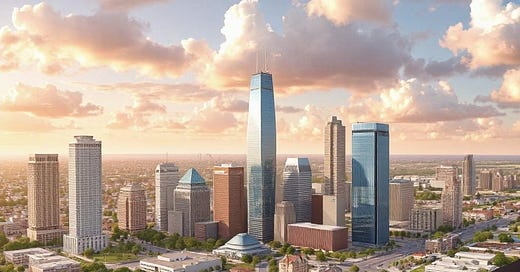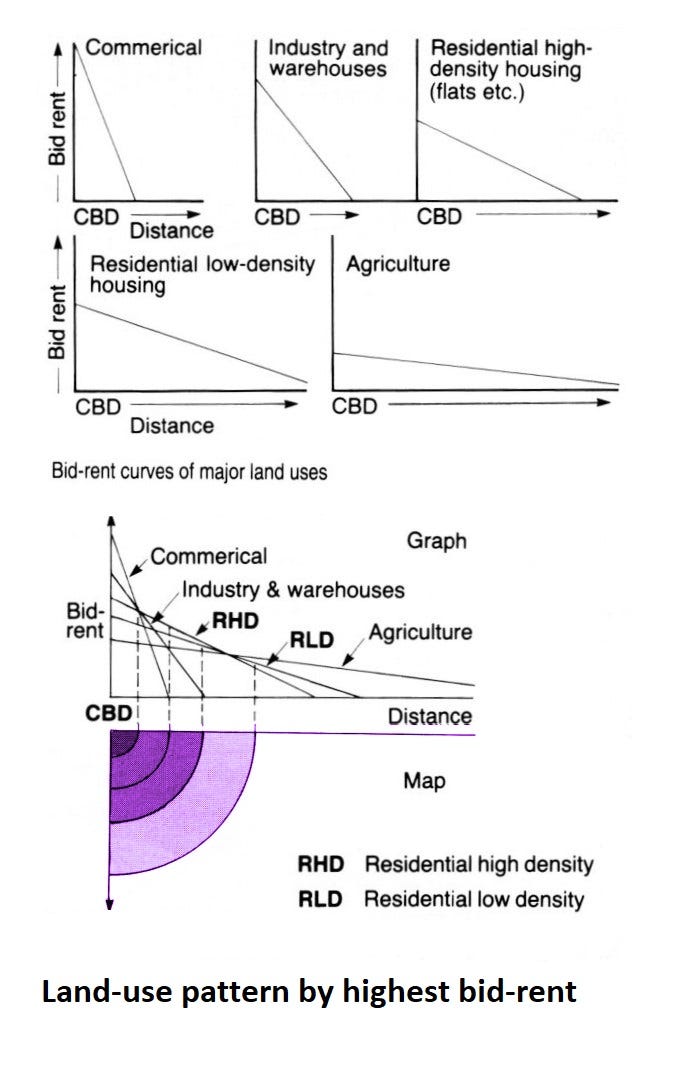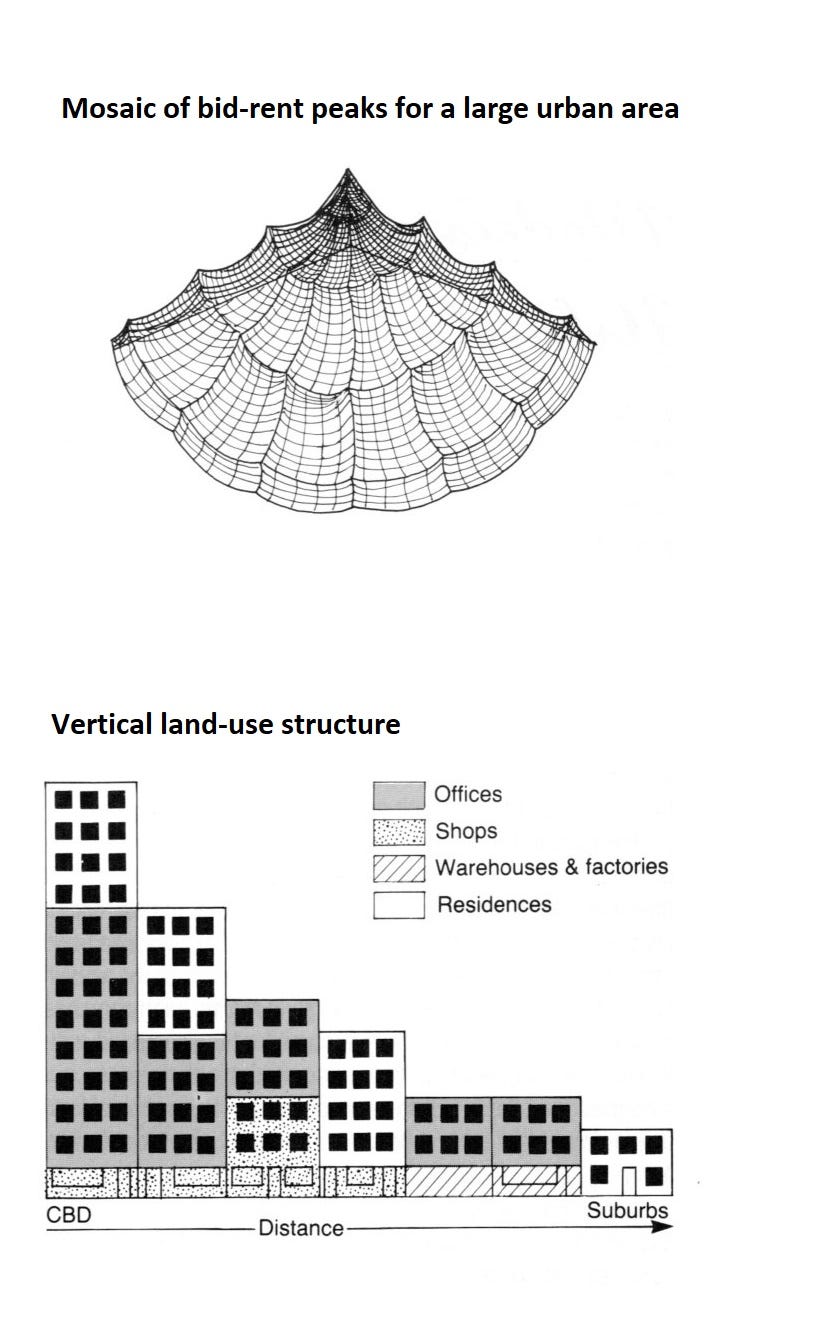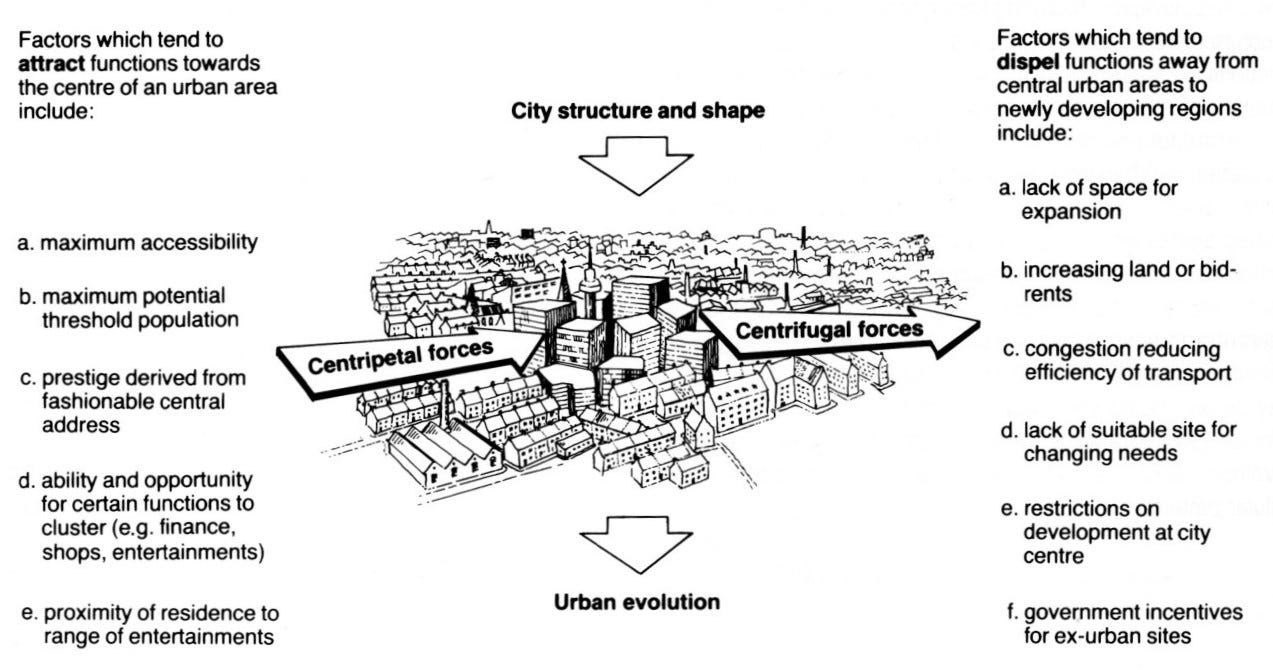Bid rent curves of major land uses in a city.
Bid rent curves illustrate the relationship between the rent that people are willing to pay for a particular land use and the distance from the city centre. They help explain the spatial distribution of different land uses within a city. Major land uses, such as residential, commercial, and industrial, exhibit distinct bid rent curves due to variations in their economic characteristics and demand patterns. Let's explore the bid rent curves for these major land uses in a city:
Residential Land Use: The bid rent curve for residential land use typically shows that people are willing to pay higher rents for housing closer to the city centre. This is because central locations offer proximity to employment opportunities, amenities, cultural attractions, and transportation hubs, making them more desirable. As one moves away from the city centre, the bid rent declines, reflecting lower accessibility and often larger lot sizes or less desirable neighbourhoods. However, there may be localised spikes in rent near desirable suburban areas or specific amenities.
Commercial Land Use: The bid rent curve for commercial land use, such as retail and office space, exhibits a different pattern. Businesses are willing to pay higher rents for locations with high pedestrian or vehicular traffic, visibility, and accessibility to customers and clients. Therefore, prime locations closer to the city centre, major intersections, or transportation nodes command higher rents. As one moves away from these prime locations, rents gradually decrease due to reduced accessibility and lower visibility.
Industrial Land Use: The bid rent curve for industrial land use shows that industries tend to be located farther away from the city centre. Industrial land uses often require larger plots, lower land costs, and proximity to transportation infrastructure like highways, ports, or rail lines. As a result, industrial activities tend to move towards the periphery of the city, where land is more affordable and transportation connections are readily available. However, there may be exceptions for certain industries that require closer proximity to other sectors or specialised infrastructure.
These bid rent curves illustrate the spatial competition for land use within a city. The combination of demand, accessibility, and proximity to key amenities or resources shapes the rent levels and the spatial distribution of various land uses. The bid rent curves can help urban planners and policymakers understand the dynamics of land use within a city and make informed decisions about zoning, infrastructure development, and transportation planning to ensure efficient land allocation and sustainable urban development.
The centrifugal and centripetal forces that are at work in attracting and dispelling functions in the CBD
In the context of a Central Business District (CBD), centrifugal and centripetal forces refer to the factors that either attract or dispel functions or activities from the CBD. These forces influence the spatial dynamics and evolution of the CBD. Let's explore these forces in more detail:
Centripetal Forces: Centripetal forces act to attract functions and activities towards the CBD. These forces typically arise from the following factors:
Accessibility: The CBD is often the most accessible part of the city, with well-developed transportation networks, including roads, highways, and public transit systems. Easy accessibility facilitates the movement of people and goods to and from the CBD, making it an attractive location for businesses, retail establishments, and services.
Agglomeration Economies: Concentrating economic activities in the CBD creates opportunities for agglomeration economies, which refer to the cost advantages and productivity gains that arise from the proximity of firms and industries. Proximity to other businesses, suppliers, clients, and a skilled labour pool can lead to increased efficiency, knowledge sharing, and innovation.
Market Concentration: The CBD often serves as a hub for consumer-oriented activities, such as retail, dining, entertainment, and cultural events. The concentration of businesses and amenities in the CBD creates a vibrant and diverse market that attracts consumers and generates foot traffic.
Prestige and Image: The CBD often represents the symbolic and prestigious heart of the city. High-profile institutions, iconic landmarks, corporate headquarters, and government offices may be concentrated in the CBD, enhancing its image and attracting businesses, professionals, and tourists.
Centrifugal Forces: Centrifugal forces, on the other hand, act to dispel functions and activities away from the CBD. These forces typically arise from the following factors:
Land Costs: The CBD tends to have higher land costs due to its prime location and high demand. As a result, businesses may be priced out of the CBD and seek more affordable locations in the outskirts or suburban areas.
Space Constraints: The CBD may face spatial limitations, making it difficult to accommodate certain activities that require larger floor areas, such as manufacturing or warehousing. As a result, such activities may relocate to areas with more available space outside the CBD.
Changing Accessibility: Over time, transportation infrastructure and patterns may change, leading to the development of alternative business districts or commercial nodes in other parts of the city. Improved transportation connections and the decentralisation of economic activities can reduce the centrality of the CBD.
Urban Planning Policies: Urban planning policies, such as zoning regulations or redevelopment initiatives, may promote the dispersal of functions from the CBD. These policies may encourage the development of satellite business districts, mixed-use developments in other parts of the city, or the creation of specialised economic zones.
Understanding these centrifugal and centripetal forces is crucial for urban planners and policymakers when considering strategies for CBD development, revitalisation, and managing urban growth. Balancing the attractive forces that retain and promote functions in the CBD with the dispelling forces that encourage decentralization can help create a well-functioning and sustainable urban core.
Questions
What are the most important factors influencing the development of different functional zones within cities?
What are bid-rent curves?
Why do land values decline with increasing distance from the CBD?
What are the centripetal and centrifugal forces that interact in in urban evolution?
FEEL FREE TO BUY ME A COFFEE IF YOU LIKE MY FREE RESOURCES
or one of my inexpensive books at
Amazon.co.uk: Ritchie Cunningham: books, biography, latest update









